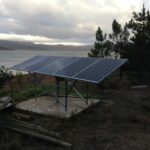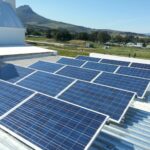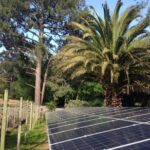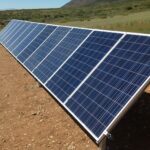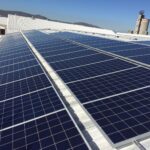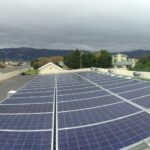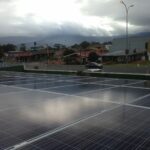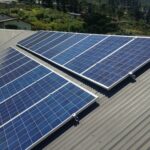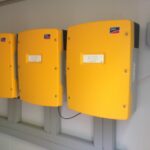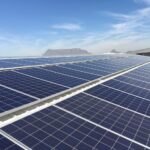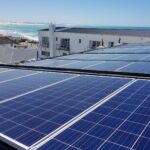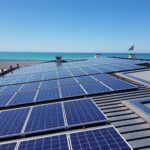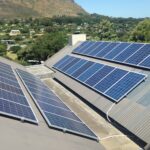Frequently Asked Questions
Residential Solar
Yes! BC Hydro and Fortis allow users to join their Net Metering program and feed all their excess solar into the grid for a 100% kWh credit.
You can bank your excess solar power in the summer for use during the winter months.
An example:
If you feed 5,000kWh (electrical units) into the grid in the summer, once your solar produces less and you go into the winter months you would first use up all your stored energy credit on your account before being charged again for electricity. Once you have used up all your credit, then you simply go back to normal rates as before.
Have a look at our Residential Page for an explanation about net metering.
It's one of the best deals on the planet.
Most residential systems cost between $20,000 to $35,000. In most cases you get more value for money with larger systems because there are certain fixed costs associated with installing any system no matter the size. Solar is priced in $/W and can range from $3.5/W for small systems down to $2.1/W on larger systems. The chosen hardware also has an effect on the price, micro inverters are usually cheaper while brands like SolarEdge and Enphase are more expensive but add a lot more features and upgradability.
If there is sunlight outside, your solar panels will produce power. Solar panels work best with direct sunlight on them, so any clouds, rain, snow, smoke, smog or dust will have a negative effect on their production.
Solar simulation software will account for your local area's year round weather conditions, so the models that are presented to you will take all of these factors into account to produce the simulated energy yields.
To see an example of the effect, have a look below at the same site showing a perfect summer day vs a perfect winter day vs a rainy/cloudy winter day
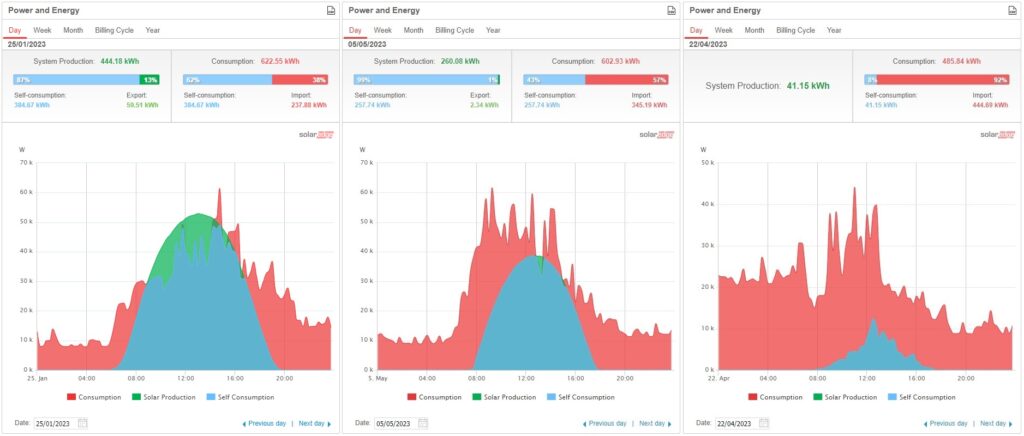
We definitely don't recommend cleaning your solar panels if it is dangerous to do so. Solar panels do produce the most energy when receiving the purest and most direct sunlight, so cleaning your panels will surely give you better energy yields.
HOWEVER, the effort of cleaning panels are significant, the gains are not stellar and the time it takes for them to accumulate the same amount of dust are usually fairly short, so in most cases we don't clean solar panels and let God take care of cleaning them with rain, wind and snow.
Solar panels get very hot during sunlight hours, so if you clean them with water, make sure it's in the early morning or evening to avoid cold water on hot surfaces that might crack them as a result.
Grid-tie solar require an active grid to connect to, so if there is no grid, they have to shut down.
It is a safety law required by all international electrical codes. If a technician works on your wiring or on the grid upstream of your home, there is a risk they may be electrocuted if this was allowed.
If you had a battery backup system, it would produce the grid required for the grid-tie solar to remain on during an outage. It would also control the solar if the grid is off and not allow any power to feed into the grid, thus satisfying the safety concerns and keeping your solar running.
Depending on the size of the system and the complexity of the roof, it can take anything from 1 to 3 days in most cases.
Absolutely! Ground mounted solar is very effective for larger systems, it has the advantage that you can set it up with the ideal angle and orientation, as well as avoid shade from trees or roof obstructions.
Absolutely! Clay or cement roof tiles are the normal roof tiles in other popular solar countries around the world. There are special brackets that are used to to connect to the roof structure under the tiles.
Tiled roof solar installations usually take a bit longer and may cost a little bit more than normal solar installations.
It is also highly likely that while working on a tiled roof, some of the existing roof tiles will break, so it is imperative that you have some spare roof tiles available for us to replace any broken tiles.
Solar panels have improved steadily over time ever since they were invented. Every few years a new technology is released and we have seen a small step in efficiency gain.
Since the 1990's we have seen efficiency slowly advancing from 5% to around 20% currently.
Solar components are getting more expensive and the efficiency gains are not going to overtake the cost increases.
The best time to get solar is right now! (Because the government rebates and loan makes it too good to pass up)
Not anymore, the price of solar is steadily increasing.
Solar panels and completed project costs have been coming down since their invention UNTIL June 2020 when it hit the bottom and since then it has been trending upwards.
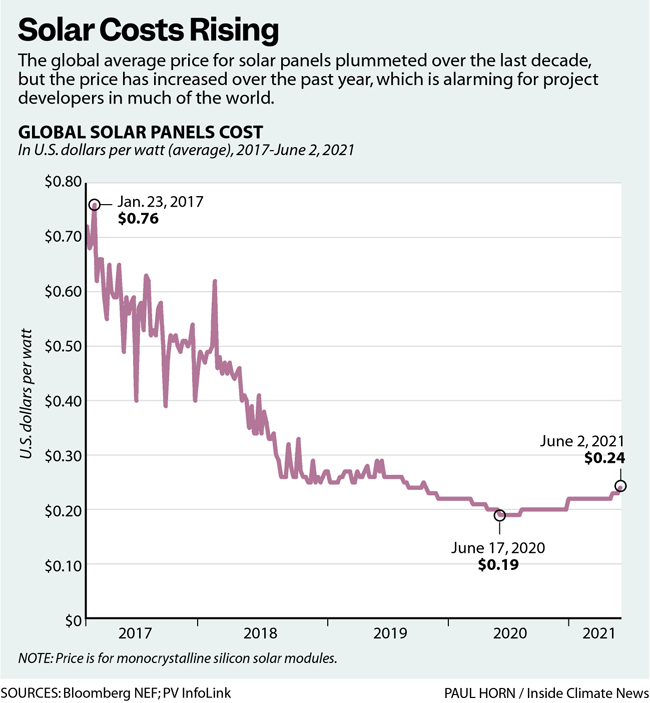
An inverter will produce AC grid power from DC solar panels, in some cases that is all you need while in other cases you may want expandability, more features, better monitoring etc.
Here are a list of good residential inverters and some of their key features:
- SolarEdge - Panel level optimization, great monitoring, highly expandable
- Fronius - String Inverter, Good Value for money
- SMA - String, Top Global German Brand, highly expandable
- Hoymiles - Micro-inverter, very reliable, good value for money, 25 year guarantee
- Enphase - High end brand, highly expandable, panel level optimization and monitoring
- APSystems - Micro-inverter, good value for money, panel level optimization and monitoring
Absolutely!!
Currently there is grant and a loan from the Canada Greener Homes Program.
Grant:
You can get up to $5,000.
The grant program gives you $1/W of installed Solar PV up to $5,000. So for any system over 5kW, you would be eligible for the full $5,000.
Loan:
You can get up to $40,000 on a 10 year 0% interest loan to pay for your solar.
It really is the best time in history to get solar!
Commercial Solar
Yes! Just as with residential Solar, for commercial customers BC Hydro and Fortis allow users to join their Net Metering program and feed all their excess solar into the grid for a 100% kWh credit.
You can bank your excess solar power in the summer for use during the winter months.
An example:
If you feed 50,000kWh (electrical units) into the grid in the summer, once your solar produces less and you go into the winter months you would first use up all your stored energy credit on your account before being charged again for electricity. Once you have used up all your credit, then you simply go onto normal rates as before.
Have a look at our Commercial Page for an explanation about net metering.
It's one of the best deals on the planet.
Most Commercial systems are larger systems and would be at the lower end of the price tier. In most cases you get more value for money with larger systems because there are certain fixed costs associated with installing any system no matter the size. Solar is priced in $/W and commercial systems can range from $3/W for small systems down to $1.9/W on larger systems with ideal conditions. Flat roof installations require more mounting hardware and hence would be more expensive than flush mounted installations. On commercial installations you will usually use string inverters like Fronius, SolarEdge or SMA.
If there is sunlight outside, your solar panels will produce power. Solar panels work best with direct sunlight on them, so any clouds, rain, snow, smoke, smog or dust will have a negative effect on their production.
Solar simulation software will account for your local area's year round weather conditions, so the models that are presented to you will take all of these factors into account to produce the simulated energy yields.
To see an example of the effect, have a look a at the 65kW installation on a factory below showing a perfect summer day vs a perfect winter day vs a rainy/cloudy winter day

Solar panels have improved steadily over time ever since they were invented. Every few years a new technology is released and we have seen a small step in efficiency gain.
Since the 1990's we have seen efficiency slowly advancing from 5% to around 20% currently.
Solar components are getting more expensive and the efficiency gains are not going to overtake the cost increases.
The best time to get solar is right now! (Because the government rebates and loan makes it too good to pass up)
Not anymore, the price of solar is steadily increasing.
Solar panels and completed project costs have been coming down since their invention UNTIL June 2020 when it hit the bottom and since then it has been trending upwards.

For commercial installations we would almost always do a structural review to ensure your roof structure can handle the added weight of a solar array.
Solar panels weigh very little compared to the amount of surface area they take up, so the weight is distributed across a very large area.
In my 12+ years doing solar I have only once come across a roof that was not able to bear the weight of solar, so the chances are very likely that your roof will be fine to carry solar.
Battery Backup Systems
In most cases the answer is No.
Because in British Columbia, Canada we can feed all our excess solar power into the grid for 100% credit, a battery's only added benefit is to keep your essential loads on during a power outage.
Therefore, for most residential and commercial systems a battery is not required and not recommended.
This is a difficult question as it greatly depends on what you want to keep running when the power is off. You need to decide if you want only 120V loads, then you might get away with a smaller unit and less batteries, or if you need a 240V system it will be larger and require a bigger battery bank.
Backup systems are not cheap! Lithium batteries are substantially more expensive than lead acid batteries.
As an example:
A 240V system Schneider 6.8kW inverter with 20kWh of Lithium batteries will cost around $30,000
My all time favorite battery inverter is Victron. Over the years they have proven to be extremely reliable, very powerful and they have hands down the nicest on site display and online monitoring portal.
Sadly though Victron has a fairly limited offering in Canada that are CSA approved and inverters are all 120V meaning you require 2 of them for a 240V system.
Luckily there is another great choice in the Schneider Conext XW Pro, an incredibly powerful unit with that is 240V out of the box.
Yes you should, if you can...
Battery technology is currently the fastest developing segment of the solar market and prices are being driven down as companies ramp up production and compete for position in the market.
Electric vehicles are also improving rapidly and very soon we will have bi-directional charging where your EV will be your home battery. The Ford Lightning already has this feature available with some extra hardware.
Both lead-acid and lithium batteries have a strong case to make and both still have their purpose.
Lead-Acid batteries have a higher discharge ability than lithium allowing you to get away with less batteries saving you substantial costs.
Lithium have a higher efficiency losing about 5% energy round trip compared to lead-acid's 30%. So for regular use, lithium will save you a lot of money in running costs and a smaller solar system.
New changes to the Canadian electrical code also makes it hard to install certain batteries in certain locations legally and this too might influence the options available to you.
Verdict:
For a backup only need I would favor lead acids,
For a more frequent use I would favor lithium.
Off-Grid Solar Systems
I don't know if some do, but for us, it's one of our favorite systems and we've done plenty of them!
As with a battery backup system, this is a difficult question as it greatly depends on what you want to keep running when the power is off. You need to decide if you want only 120V loads, then might get away with a smaller unit and less batteries, or if you need a 240V system it will be larger and require a bigger battery bank.
Lithium batteries are substantially more expensive than lead acid batteries, but are well worth it for most off-grid installations.
As an example:
A 240V system Schneider 6.8kW inverter with 20kWh of Lithium batteries will cost around $30,000
My all time favorite battery inverter is Victron. Over the years they have proven to be extremely reliable, very powerful and they have hands down the nicest on site display and online monitoring portal.
Victron can have multiple units in parallel and set up for single 120 or 240, split 240 or 3 phase for a maximum system size of 180kW if that much power is required.
SMA is another great option that have been making off- grid inverters for many years. Just as with Victron SMA inverters can be combined to build a system of up to 100kW.
Another great choice is the Schneider Conext XW Pro, an incredibly powerful unit with that is 240V out of the box, 4 of these can be combined for a system size of up to 27kW.
No, in my experience hybrid inverters don't have the power to start a lot of the common regular day to day loads.
If you are curios, just search for "Solark vs Schneider" on YouTube and see how people put them through real life tests.
Popular hybrid inverters are SolArk, Goodwe, Sunsynk, Axpert, Voltronics to name a few. These all have more or less the same characteristics: A square box made of flat metal sheets, they are really light for their rated output capacity and they have a cheap looking LCD screen that looks like it's from the 90's. They look decidedly "made in China".
Hybrid inverters are very popular due to their ease of installation and lower cost, but being an engineer, I cannot bring myself to like and approve of them. So I don't recommend using a hybrid inverter for almost any application.
For a grid-tie inverter to work in an off-grid setup it needs to be able throttle it's power output based on the frequency of the backup inverter. This is known as "frequency shifting" or "frequency watt shifting".
These are the brands I have worked with doing off grid installations:
- SolarEdge
- Fronius
- SMA
- Hoymiles
Depending on your inverter some options may work better in certain situations.
Both have pro's and con's so if possible in an ideal world it's best to do both AC and DC coupling for off-grid.
AC coupling produces power directly to the loads, meaning there is only 1 conversion from solar to AC. The downside is that your backup inverter needs to charge the batteries and in most cases they will have a lesser capacity than the inverters are supplying, so if you are not consuming all your power, your grid-tied inverters will have to throttle back resulting in lost solar production.
DC coupling directly charges the batteries, so using DC chargers allows for full usage of your solar power until the batteries are full. To get usable AC power there are 2 conversions, 1 from solar to 48V and again by the backup inverter to 240V resulting is slightly less efficiency.
AC coupling will result in a higher usable peak power because your grid tie-inverter produces power for the load and your backup inverter can too. For example, 10kW of Grid-tie with 10kW of Backup means you can run a 20kW load in peak solar conditions.
For the same system DC coupled, your 10kW backup inverter is your only source of AC power, so that is the maximum load you can run before getting to the overload threshold.
Lithium batteries win hands down for an off-grid system.
Lithium have about a 5% energy loss round trip compared to lead acids of about 30%, meaning you get 25% more energy from your solar that you charge and discharge from your battery bank with lithium.
Partial charging is what severely shortens the life of lead acids. Lithium does not have this problem.
Most lithium batteries carry a 10 year guarantee in most cases as well as a smaller form factor, no gasses and closed loop communication with most quality inverters allowing accurate monitoring of your expensive battery asset.

